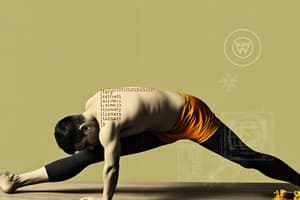Podcast
Questions and Answers
Dynamiczne rozciąganie angażuje aktywne ______ i jest najlepiej wykonywane przed angażowaniem się w aktywności fizyczne.
Dynamiczne rozciąganie angażuje aktywne ______ i jest najlepiej wykonywane przed angażowaniem się w aktywności fizyczne.
ruchy
Statyczne rozciąganie natomiast jest najlepiej odpowiednie dla sesji po treningowej, aby pomóc ______ i rozluźnić mięśnie.
Statyczne rozciąganie natomiast jest najlepiej odpowiednie dla sesji po treningowej, aby pomóc ______ i rozluźnić mięśnie.
odprężyć
Różnorodność ćwiczeń zwiększających elastyczność jest istotna dla ogólnej ______ organizmu.
Różnorodność ćwiczeń zwiększających elastyczność jest istotna dla ogólnej ______ organizmu.
elastyczności
Dobrze zrównoważony program treningu powinien zawierać zarówno dynamiczne, jak i statyczne ______, aby osiągnąć optymalne korzyści elastyczności.
Dobrze zrównoważony program treningu powinien zawierać zarówno dynamiczne, jak i statyczne ______, aby osiągnąć optymalne korzyści elastyczności.
Rozciąganie dynamiczne naśladuje rzeczywiste ______, które wykonasz podczas rutyny treningowej.
Rozciąganie dynamiczne naśladuje rzeczywiste ______, które wykonasz podczas rutyny treningowej.
Yoga to popularna forma ćwiczeń znana ze swoich korzyści dla ______.
Yoga to popularna forma ćwiczeń znana ze swoich korzyści dla ______.
Pilates to forma ćwiczeń o niskim wpływie, skupiająca się na budowaniu siły ______, giętkości i równowagi.
Pilates to forma ćwiczeń o niskim wpływie, skupiająca się na budowaniu siły ______, giętkości i równowagi.
Foam Rolling to forma samodzielnego uwalniania mięśni, polegająca na użyciu wałka ______, aby wywierać nacisk na mięśnie i tkanki miękkie.
Foam Rolling to forma samodzielnego uwalniania mięśni, polegająca na użyciu wałka ______, aby wywierać nacisk na mięśnie i tkanki miękkie.
Ćwiczenia ze ______ oporowymi w Twoim treningu rozciągającym mogą pomóc poprawić Twoją giętkość i zakres ruchu.
Ćwiczenia ze ______ oporowymi w Twoim treningu rozciągającym mogą pomóc poprawić Twoją giętkość i zakres ruchu.
Ballistyczne rozciąganie polega na gwałtownych, silnych ruchach w celu rozciągnięcia Twoich ______.
Ballistyczne rozciąganie polega na gwałtownych, silnych ruchach w celu rozciągnięcia Twoich ______.
Flashcards are hidden until you start studying
Study Notes
Flexibility Exercises and their Importance in Fitness Routines
Flexibility is a crucial aspect of fitness that often gets overlooked by many exercisers, particularly those who focus exclusively on building strength and endurance. However, incorporating flexibility exercises into your workout routine can significantly improve your overall physical health and performance. In this article, we will explore various types of stretches and exercises you can include in your fitness regimen to enhance your flexibility and promote better mobility.
Stretching Techniques
A well-rounded fitness program includes both dynamic and static stretches to achieve optimal flexibility benefits.
Dynamic Stretching
Dynamic stretches involve active movements and are best performed before engaging in physical activities to prepare your body for exertion. These exercises mimic the actual movements you will perform during your workout routine, making them ideal for athletes or individuals who prefer exercise classes and group activities.
Static Stretching
Static stretches, on the other hand, are best suited for post-workout sessions to help relax and unwind your muscles. This type of stretching involves holding a position for a set period of time, typically 15 to 30 seconds, and can be done at any time of day.
Flexibility Exercises and Techniques
Incorporating a variety of flexibility exercises into your routine is essential for overall flexibility. Here are some exercises and techniques you can try:
Yoga
Yoga is a popular form of exercise known for its flexibility benefits. Practicing yoga regularly can help improve your range of motion, posture, and overall flexibility.
Pilates
Pilates is a low-impact form of exercise that focuses on building core strength, flexibility, and balance. It is particularly beneficial for individuals with lower back pain or limited mobility.
Foam Rolling
Foam rolling is a form of self-myofascial release that involves using a foam roller to apply pressure to your muscles and soft tissues. This technique can help release tension and improve your flexibility, as well as promote blood flow and muscle recovery.
Resistance Band Stretches
Using resistance bands in your stretching routine can help improve your flexibility and range of motion. These bands provide resistance, allowing you to hold stretches for longer periods and target specific muscle groups.
Ballistic Stretches
Ballistic stretches involve sudden, forceful movements to stretch your muscles. These types of stretches should only be done after warming up thoroughly and under expert supervision, as they can increase the risk of injury if not executed correctly.
Benefits of Flexibility Exercises
Incorporating flexibility exercises into your fitness program offers numerous benefits, including:
Improved Range of Motion
Stretching helps improve your range of motion, allowing you to move more freely and reducing the risk of injury.
Better Posture
Improving your flexibility can help correct postural imbalances and promote better overall alignment, which is essential for maintaining proper posture and preventing back pain.
Increased Muscle Recovery
Regular stretching can aid in muscle recovery by increasing blood flow and promoting relaxation, helping your muscles recover faster between workouts.
Enhanced Athletic Performance
Better flexibility enables your muscles to generate more force and power, leading to improved athletic performance.
Conclusion
Flexibility exercises play a vital role in achieving optimal health and wellness through their ability to enhance overall mobility, reduce the risk of injury, and improve athletic performance. By incorporating a variety of stretching techniques and exercises into your fitness regimen, you can unlock the full potential of your body and enjoy the many benefits associated with increased flexibility. Remember to always warm up before static stretching and consult a professional trainer or physiotherapist if you have any concerns about implementing these exercises properly.
Studying That Suits You
Use AI to generate personalized quizzes and flashcards to suit your learning preferences.




